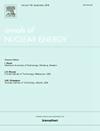A novel methodology assessment to study the performance of the physical protection system for enhancing the security of nuclear and other radioactive materials during transport
IF 1.9
3区 工程技术
Q1 NUCLEAR SCIENCE & TECHNOLOGY
引用次数: 0
Abstract
This paper presents a risk-informed model for securing radioactive materials during transport, integrating a real transport graph to simulate attack probabilities and response effectiveness. The model addresses the potential for adversarial attacks, including theft and sabotage, and evaluates the ability of the Physical Protection System (PPS) to detect, delay, and neutralize threats. Using a real-world transport network, we simulate the most plausible attack paths an adversary might take and assess the success probability of these attacks in relation to key system metrics: detection probability (), communication probability (), interruption probability (), and neutralization probability (). The model also considers the arrival time of the response force, as a critical factor influencing the overall security effectiveness. The transport graph represents the network of possible routes, critical locations, and access points, which are used to simulate adversary actions and response dynamics. Each edge in the graph represents a potential attack path, with associated probabilities for adversary success and system response. System effectiveness, , is calculated by simulating realistic attack-response scenarios. Results highlight how optimized strategies reduce adversary success while enhancing response efficiency. Case studies demonstrate the model’s utility in securing radioactive materials and improving PPS designs to mitigate theft and sabotage risks.
一种新的评估方法,用于研究物理防护系统的性能,以提高核和其他放射性材料在运输过程中的安全性
本文提出了一个在运输过程中保护放射性物质的风险知情模型,集成了一个真实的运输图来模拟攻击概率和响应效率。该模型解决了潜在的对抗性攻击,包括盗窃和破坏,并评估了物理保护系统(PPS)检测、延迟和消除威胁的能力。使用真实世界的传输网络,我们模拟攻击者可能采取的最合理的攻击路径,并根据关键系统指标评估这些攻击的成功概率:检测概率(Pd)、通信概率(Pc)、中断概率(Pi)和中和概率(Pn)。该模型还考虑了反应部队到达时间作为影响整体安全有效性的关键因素。传输图表示由可能的路线、关键位置和接入点组成的网络,用于模拟对手的行动和响应动态。图中的每条边表示一个潜在的攻击路径,以及攻击者成功和系统响应的相关概率。系统有效性Pe是通过模拟真实的攻击响应场景来计算的。结果突出了优化策略如何在提高反应效率的同时减少对手的成功。案例研究证明了该模型在保护放射性材料和改进PPS设计以减轻盗窃和破坏风险方面的实用性。
本文章由计算机程序翻译,如有差异,请以英文原文为准。
求助全文
约1分钟内获得全文
求助全文
来源期刊

Annals of Nuclear Energy
工程技术-核科学技术
CiteScore
4.30
自引率
21.10%
发文量
632
审稿时长
7.3 months
期刊介绍:
Annals of Nuclear Energy provides an international medium for the communication of original research, ideas and developments in all areas of the field of nuclear energy science and technology. Its scope embraces nuclear fuel reserves, fuel cycles and cost, materials, processing, system and component technology (fission only), design and optimization, direct conversion of nuclear energy sources, environmental control, reactor physics, heat transfer and fluid dynamics, structural analysis, fuel management, future developments, nuclear fuel and safety, nuclear aerosol, neutron physics, computer technology (both software and hardware), risk assessment, radioactive waste disposal and reactor thermal hydraulics. Papers submitted to Annals need to demonstrate a clear link to nuclear power generation/nuclear engineering. Papers which deal with pure nuclear physics, pure health physics, imaging, or attenuation and shielding properties of concretes and various geological materials are not within the scope of the journal. Also, papers that deal with policy or economics are not within the scope of the journal.
 求助内容:
求助内容: 应助结果提醒方式:
应助结果提醒方式:


